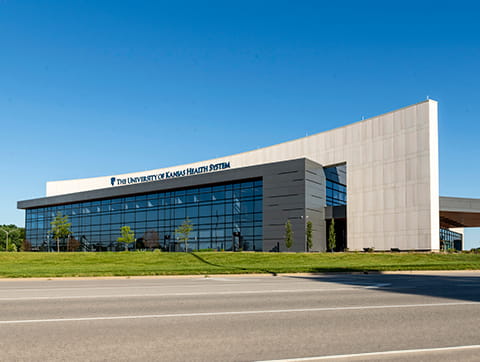May 06, 2019
According to the Centers for Disease Control and Prevention, one in four deaths is caused by heart disease. Heart disease is the leading cause of death for both men and women. But did you know heart disease is different in women? In a recent podcast Ashley Simmons, MD, a noninvasive cardiologist at The University of Kansas Health System and director of the Adelaide C. Ward Women's Heart Program talked about heart disease and how it manifests differently in women than men.
“Starting from symptoms, women present differently with symptoms,” she says. “They can have more nonspecific symptoms. They may just present with nausea, weakness, fatigue. It may not be that crushing chest discomfort that you think of as a heart attack.”
Dr. Simmons says symptoms that are not traditionally what you think of as a heart attack symptom that may be subtle.
Heart disease can impact anyone. According to the Centers for Disease Control and Prevention, one in four deaths is caused by heart disease. Heart disease is the leading cause of death for both men and women. But did you know heart disease is different in women? You’re listening to the Heart Health podcast presented by The University of Kansas Health System.
Dr. Ashley Simmons: I'm Dr. Ashley Simmons. I'm a non-invasive cardiologist at The University of Kansas Health System. I'm the director of the Adelaide C. Ward Women's Heart Program.
Be Well: We sat down with Dr. Simmons to ask her some questions about heart disease in women, unusual heart conditions and her career.
Dr. Ashley Simmons: My interest is mostly in just helping other women out. If you look at the studies of awareness of heart disease and women over the last 20 years... like in the 1980s, yes, women may have been disregarded. But if you came in with chest discomfort to our emergency room here, within five minutes, you’ll have an EKG and you’ll have somebody talking to you and, really, our emergency room physicians are really good at screening for coronary artery disease now. Nowadays, people are pretty in tune to heart disease and women presenting differently. And I think you can look at women compared to men differently throughout cardiology, from diagnostic imaging through symptoms and cardiac rehabilitation. So starting from symptoms, women present differently with symptoms. They can have more nonspecific symptoms. They may just present with nausea, weakness, fatigue. It may not be that crushing chest discomfort that you think of as a heart attack. So, paying attention to symptoms that are not traditionally what you think of as a heart attack symptom that may be more subtle like shortness of breath with activity, fatigue, dyspnea, neck discomfort, jaw discomfort, left arm discomfort and really remembering that the heart is a muscle. Oftentimes, people who present with heart attacks or pain in the chest is really more of a pressure or... pulled muscle feeling within the chest.
Be Well: So, why are women’s hearts different? Isn’t a heart and heart?
Dr. Ashley Simmons: I think you just have to be a be aware of the different anatomy between men and women. Women's arteries tend to be a little bit smaller and women tend to have more micro vascular disease compared to men that have more epicardial or large artery coronary artery disease. So women typically develop coronary artery disease along the length of the vessel instead of in, you know, big plaques. You can have it either way, but micro vascular disease is more prevalent in women. And then imaging... I think we have to be careful in imaging with women, because of the breast tissue over the heart. So you always have to look at nuclear imaging a little bit differently because the breast tissue can attenuate the images in the heart. Women metabolize drugs differently than men, just because of the body composition. I mean all the way throughout the hospitalization there's little differences that you have to pay attention to. And women tend to have much lower cardiac rehabilitation rates than men. And the reason for that is, I think, women are typically caregivers and they're you know taking care of their parents or their children and, and not necessarily taking the time to go to cardiac rehab three times a week. Being a woman, it's always interesting to me how our bodies are a little bit different and I also, I think part of my interest was, and I think we've gotten a lot better with this, but coronary artery disease, when it was under diagnosed in women. And symptoms were disregarded and that's improving quite a bit. And awareness of coronary artery disease have improved significantly with the awareness campaigns like Go Red For Women and Close the Gap and Women Heart, so all of those awareness campaigns have helped quite a bit.
Be Well: What are some unusual heart disease symptoms in women that you’ve seen in your career?
Dr. Ashley Simmons: I have had a patient that actually came in with jaw discomfort and she really was sure that she had something wrong. She had seen a dentist. Dentist said everything's fine. And it was jaw discomfort that was exertional in nature, but she was unable to relate it to her exertion. So she just came in with jaw discomfort and she totally thought she had some sort of dental disease or TMJ. And so that's an example of something that was truly anginal in nature. Her manifestation of angina was jaw discomfort. I just saw somebody today, so this is another example, because she really was shocked. She had a heart rate of 35. She was asymptomatic with it and she was sent in through primary care. But just shocked to know that in... on telemetry, she was having multiple pauses over two and a half to three seconds. So, really significant pacemaker cell or sinus node dysfunction that she was just unaware of. She had been more fatigued, hadn't passed out yet, but those symptoms can be subtle. And so she had really a an electrophysiology problem called sinus node dysfunction. But was caught unawares and just shocked that she had any heart disease at all. Some of these symptoms can be pretty subtle. So I think the important thing is to have the conversation with your primary care physician and, particularly, if you have risk factors or family history of coronary artery disease or arrhythmias or some sort of sudden cardiac arrest in particulars, to have a good conversation with your primary care doctor.
Be Well: What are some risk factors for heart disease that people should pay attention to?
Dr. Ashley Simmons: The traditional risk factors, we used to call modifiable and non-modifiable. So the modifiable ones would be smoking, hypertension, obesity, dyslipidemia or cholesterol issues, diabetes, if it's type-2, you know because that's something that, oftentimes, you can improve quite a bit with weight loss and exercise. The non-modifiable ones... if you're a, you know, Type 1 diabetic, obviously, can modify how well your blood sugars are controlled. But if you have a strong family history that's a non-modifiable one, those are your traditional risk factors. But newly recognized risk factors, particularly in women, are radiation exposure... so breast cancer radiation over the chest wall or lymphoma with radiation, radiation increases your risk about eight times. Significant risk: preeclampsia or pregnancy induced hypertension also increases your risk. We see more heart disease in women than all cancers combined. But I think if you've had radiation exposure, strong family history or multiple risk factors, it's always worth the discussion with your physician for screening.
Be Well: Are there heart conditions that are unique to women?
Dr. Ashley Simmons: Stress-induced cardiomyopathies, which is also called broken heart syndrome, are most common in postmenopausal women. Ninety percent of the time it happens in women. And it tends to be induced by a significant stressor. I've seen after a death of a loved one. I've seen a stress-induced cardiomyopathy just from excruciating pain related to chemotherapy or what have you. It's just when the body is significantly stressed and for some reason, women's hearts respond differently than men's hearts do. We see this a lot in the hospital and somebody who's really sick. Their heart basically stops pumping well. And it's called a takotsubo cardiomyopathy, which is an octopus trap. Because the distal part of the heart or the apex of the heart just stops contracting and then the mid, the mid parts are not contracting well or severely hypokinetic, what we call it, but the basal portions or the very bottom part kind of near the valve planar are contracting quite a bit. And so it looks like an octopus trap.
Be Well: How does this heart condition show up in patients?
Dr. Ashley Simmons: Usually it's manifested by discomfort. You can get some EKG changes that can mimic a heart attack. You can get elevated troponin levels that also mimic a heart attack. And then we do a coronary or an angiogram to see if there's any blockage in the heart arteries. We don't see any so, then we know it's it's induced by high norepinephrine levels and stress to the heart. And most of the time women can recover from this, but they can be very, very, very sick when they're here, requiring medicines to support blood pressure. One of the things that I fear most about this is sometimes women can form a clot in the top part of the heart or the in the apex of the left ventricle and that clot, as the heart function recovers, can travel up and cause a stroke.
Be Well: Can someone recover from broken heart syndrome?
Dr. Ashley Simmons: Most of the time the stress induced cardiomyopathies, or takotsubo is the other name for it, are reversible meaning they get better with medicines like beta blockers. But one of the feared complications of that is you can be (A) really sick when they're hospital in shock and then (B) the risk of stroke. As that heart is stunned and not moving very well so you can forma clot and as the heart rate function recovers that clot can travel up and cause a stroke. So that's kind of one of those interesting diseases that affects mostly women. I don't think anyone totally understands why it's so much more prevalent in women compared to men.
Be Well: Dr. Simmons, tell us how you got started in the cardiology field. What keeps you coming to work every day?
Dr. Ashley Simmons: I always liked the physiology of the heart. I really like the diversity that I have in my day. I was a hospitalist for two years before I went into cardiology. And I was only seeing patients inpatient and never got to see if they did well after they left the hospital and you didn't get to follow up with them. So in cardiology, I get to see very sick patients in the ICU, but then I also get to see patients for prevention and clinic and I get to follow him and get to know them and their family members and that's a rewarding part. But I also like that, like today, I had morning of rounds in the afternoon I'm doing imaging and so there's a lot of variety in my day. I think that's a huge appeal to me for cardiology there's always something new to learn. So that's cool compared to a lot of other medical fields that, you know, you may be just doing clinic every day or hospital rounds every day. And I get to kind of do a little bit of everything.
Be Well: What are some of the benefits of working at an academic medical center like The University of Kansas Health System?
Dr. Ashley Simmons: A huge pro of KU and any academic medical center is that you have a lot of people looking at the patient, trying to figure out the best thing, but, you know, for example, yesterday was reading echoes and a colleague of mine was reading CTs and it was a complicated congenital CT and it was a referral from an outside Hospital where an electrophysiologist really had difficult time accessing the heart, because of some congenital abnormal veins. And, you know, there were five cardiologists in there looking at the scan together figuring out what was going on we had the electrophysiologist trying to figure out how he was going to access this heart and so that's an example of a really good collaborative approach for this one patient, yeah, you know, a total of six people looking at that scan trying to figure out the best way for the electrophysiologist to approach the heart for a bleeding and arrhythmia. I mean, that's an example of kind of the collaborative approach that is here so it's kind of cool.
Be Well: If you could leave our listeners with one take away – what would you tell them?
Dr. Ashley Simmons: Knowing your numbers, I mean, so that's one of the things that we always focus on. What are your numbers? What's your blood pressure running? What are your cholesterol numbers running? Those are probably most important numbers to keep it, keep track of. If you feel like you are having symptoms that are concerning for heart disease, like palpitations or you're noticing chest discomfort or shortness of breath or significant fatigue or, really, any symptoms that make you concerned. Or if you have an early family history of sudden cardiac arrest or an early family history of heart disease, I would recommend talking to your primary care physician and getting your numbers checked, getting your blood pressure and cholesterol checked. And your primary care physician may choose to check an EKG or refer you on to cardiology for further evaluation.
Symptoms of heart disease
- Shortness of breath with activity
- Fatigue
- Dyspnea (difficulty breathing)
- Neck discomfort
- Jaw discomfort
- Left arm discomfort
- Pressure or pulled muscle feeling within the chest
Why are women’s hearts different?
“I think you just have to be a be aware of the different anatomy between men and women,” says Dr. Simmons. “Women's arteries tend to be a little bit smaller and women tend to have more micro vascular disease compared to men that have more epicardial or large artery coronary artery disease.”
Imaging with women is different, because of the breast tissue over the heart, she says.
"You always have to look at nuclear imaging a little bit differently because the breast tissue can attenuate the images in the heart."
Risk factors for heart disease include:
- Smoking
- Hypertension
- Obesity
- Dyslipidemia or cholesterol issues
- Diabetes
Newly recognized risk factors, particularly in women:
- Radiation exposure
- Preeclampsia or pregnancy induced hypertension




